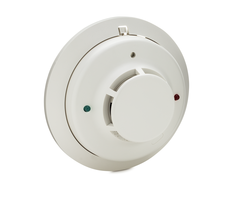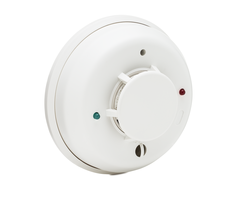Deciding Whether to Use 2-Wire or 4-Wire Smoke Detectors
Related Products





Related Categories
Description
In this video, Joe from Alarm Grid helps you determine whether you should use 2-wire or 4-wire smoke detectors with your hardwired security panel. As a general rule, 2-wire smoke sensors are much easier to use and install. But keep in mind that 2-wire smoke sensors must be used on a designated zone.
A 2-wire smoke detector will receive automatic reset commands from the panel. But with that in mind, you can only use a 2-wire smoke detector with a hardwired zone that will automatically reset the sensor after a fire alarm is cleared. On a Honeywell VISTA System, this is Zone 1. But a 4-wire smoke detector will not have this restriction and can be used on any hardwired system zone. But as long as you save the designated smoke reset zone for your 2-wire smoke detectors, then there should be no issue.
The major downside to using a 4-wire smoke detector is that a lot of extra equipment is required. This extra equipment is needed to reset the smoke detector after an alarm is cleared. This required equipment includes a power supply and a relay. This extra equipment makes the setup process more difficult. For that reason, most DIY users prefer 2-wire smokes that can just be wired to the panel directly.
Both 2-wire and 4-wire smoke detectors require the power reset after an alarm is cleared. This is necessary for stopping the smoke detector from sounding. Once the smoke detector is reset, it will go back into its quiet default state. It will only begin sounding its alarm when it detects smoke, or when the device is being tested. Since 2-wire and 4-wire smoke detectors really do the exact same thing, you should just go with whichever one is easier to set up. This is usually a 2-wire smoke detector.
https://www.alarmgrid.com/faq/how-do-i-know-whether-to-use-2-wire-or-4-wire-smoke-detectors
http://alrm.gd/get-monitored
Transcript
Hi, DIYers! Joe from AlarmGrid. And today we're going to talk about whether you should use a two-wire or a four-wire smoke detector. Today, I have a two-wire smoke detector, but the four-wire smoke detector of this particular model, looks exactly the same. And they do the same thing. So why use a two-wire or a four-wire? The main difference between the two-wire and the four-wire smoke detector is that one works with two-wires and one works with four-wires. A two-wire smoke detector has a pair of wires going back and connecting to the alarm system. These two wires handle power and data for the smoke detector. On a four-wire smoke detector, this is broken up. So one pair is going to be for the data connection, and one pair is going to be for the power connection. Either of these smoke detectors actually need their power to be cut when an alarm occurs so that they can reset. On a two-wire smoke detector, if you have it connected to a VISTA alarm system, zone 1 on that VISTA alarm system has a power reset feature. That means is that when this two-wire smoke is connected to that alarm system, after an alarm occurs and the user disarms the alarm system, that's going to temporarily cut power to the smoke detector so that it can reset. It's a really nice aspect of a two-wire smoke with a VISTA system or any other system that does that particular function. A four-wire smoke detector has two-wires dedicated for its power and two-wires for its data. What that lets you do is gives you a little more flexibility for installation, because you can install it on a system that doesn't have a dedicated power reset terminal like a VISTA. You could wire up a smoke detector to a relay and a power supply, so that the power could be cut, whatever particular alarm system goes into alarm, so that the smoke detector can reset. So as you can see, depending on what installation you're going to put the smoke detector into could change whether you're going to use a two-wire smoke detector or a four-wire smoke detector. If you have a wireless system, also, there's an even better chance that you're not going to use a wired smoke detector at all, and you just put a wireless one up. If you do have a VISTA system or a system with a power reset function on it, though, the two-wire smoke is going to be easier to install as you just have to get a pair of wires from the alarm system to the smoke detector, wire it up, then you're good to go. On the VISTA system, as an example, you can install more than one two-wire smoke onto that single terminal. All you have to do is wire them up in parallel, put a resistor at one of the smokes to be that end-of-line resistor. Ideally, you want to put it on the one furthest away from the panel so that the whole line is supervised, and you'll be good to go. Now let's talk about power supervision on the four-wire smoke. On a four-wire smoke, we have two connections for data, two connections for power. Our data connection is likely going back to our alarm panel to an open zone. And our power connection's likely going back to either the alarm panels, power output, or an auxiliary power supply. Most smoke detectors are normally open, so if something happens to the power connection to the smoke detector, there's nothing in the smoke detector that's going to tell us that something's wrong with the device. What you can do to remedy this is install a power of supervision relay module. And if you have questions about installing these or how to set it up, check our website out or give us a call, because it can be tricky and a little confusing. Basically, what this does is that it sits and it monitors the power connection to the smoke detector. If something goes wrong with the power, the relay is going to open and put the smoke into trouble telling you or us that something happened to the power coming to the smoke detector. This is a really helpful device, especially if you have four-wire smokes installed, because you do want to know if they have power applied to them or not. You just have to make sure that the smoke detectors that you do install don't exceed the maximum amount that the panel can handle. And if you check the panel's installation manual, it will tell you what it can do or not. So again, if you do have any questions about whether or not you should use a two-wire or four-wire smoke, what works for your system, or really if you should go wireless in general, feel free to give us a call at 888-818-7728. Send us an email to support@alarmgrid.com, or head to our website, www.alarmgrid.com. If you did enjoy the video, feel free to subscribe. And if you want to be notified when we post future videos, hit the notification button below, and we'll send you an update when we do so. Thanks for watching, and have a great day.
- Uploaded


